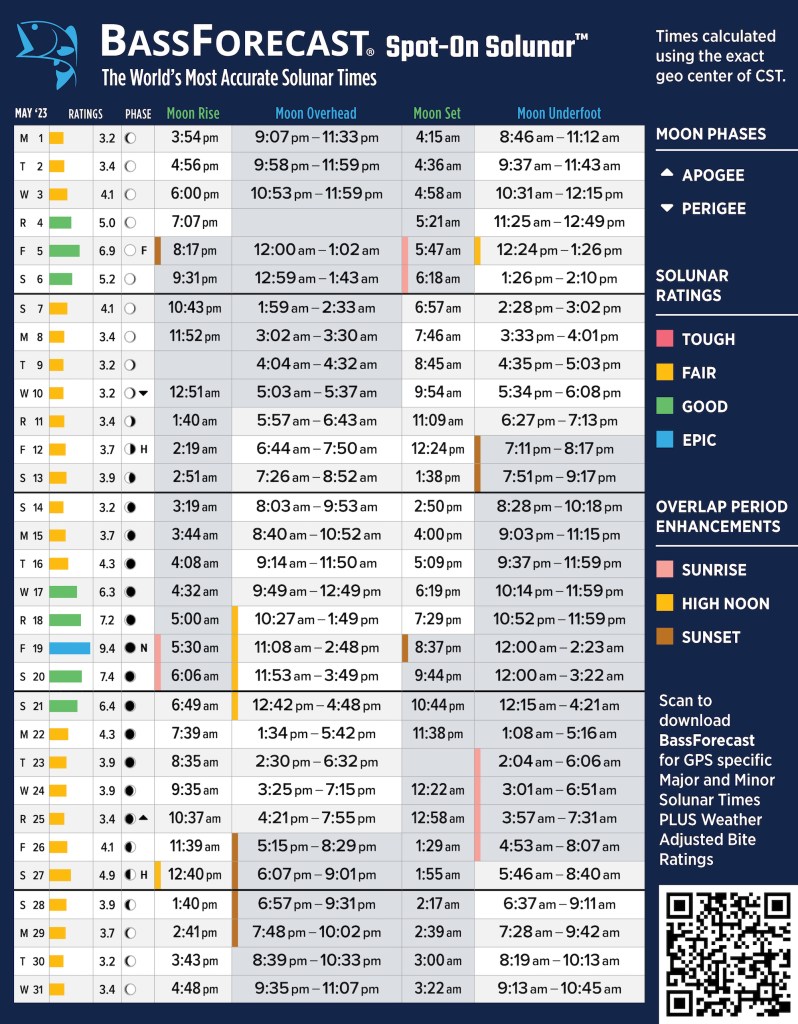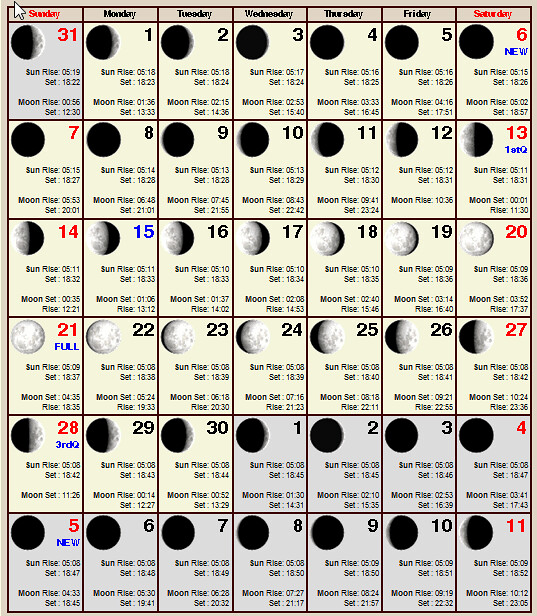When fishing for any type of species any kind of tip or information to get you to a successful day or night on the water whether lure color, type of bait, or fishing spot can be great information for any serious angler but what about Solunar Forecast, or Moon Pase Calendars do they actually work. What is a Solunar Forecast?
Solunar tables predict four periods of feeding two Major and two Minor every 24 hrs. corresponding to the moon’s position relative to Earth and to a lesser degree, the sun’s position-Major periods span 60 & 90 min. when the moon is overhead and again when it’s opposite (moon over and moon under).
Everyday sunrise, sunset, moon rise, and moon set as the most important factors triggering factors of both fish and game. The simple rise and set of both the sun and moon have far more impact than any other daily sun or moon position.
Solunar Forecast
When fish of all sizes are feeding infrequently due to a prolonged time of bad weather conditions, there is a small window that opens up for three to four days right after the actual moon peaks, full or new, which may be the only time that the largest fish of any species is surely catchable. Fishing during the daily rise or set of the sun and moon during these key monthly moon phases is key to using the Solnar forecast.
Weather is also a third factor, and helps to determine the impact of the daily rise and set of the sun or moon. It further elevates the entire chance of big fish possibilities when all three factors happen at relatively the same time. Bingo!
This period of time is called Photoperiod during which an organism receives illumination for the longest period of time. Changing weather patterns combined with a good monthly moon phase and rise or set of either sun or moon can activate some major movement from big fish and their eating habits.
The Solunar Theory
The Solunar theory is a hypothesis that fish and other animals move according to the location of the moon in comparison to their bodies. The theory was laid out in 1926 by John Alden Knight but was said to be used by hunters and fishermen long before the time it was published. 
Solunar tables are tables that fishermen and hunters use to determine the best days of the month and times of the day for catching fish and hunting games. Knowing the time of the tides, sunrise, and sunset help fishermen predict when fish are going to bite.
Most people incorrectly refer to Solunar times as the Moonup or Moondown times. This is not correct as the sun’s position in relation to the moon must also be considered. These are the times the moon is directly overhead or directly underfoot for the given location. Many hunters feel that the lunar influences are greatest at these times.
What are Major and Minor Moon Phases for Fishing?
Major periods occur when the moon is directly overhead or directly below a reference latitude. Minor periods happen when the moon is positioned 90 degrees on either side. The movements of the earth and moon mean that majors.…………………………………………………read more
Moon Phases Calendar
As the Moon orbits around Earth and the Earth orbits around the Sun, the angle between the Sun, Moon, and Earth changes. As a result, the amount of sunlight that reflects off the Moon and travels to our eyes changes every day. The Moon itself cannot produce light of its own.
We see the Moon’s disk change from all dark to all light to all dark again:
This span of time is called a lunar cycle, lunation, lunar month, or synodic month. The length of the cycle can vary slightly, but on average, it is 29.53059 days.
Astronomers have broken down this cycle into four primary Moon phases:
New Moon, First Quarter, Full Moon, and Last Quarter. There are also four secondary phases: Waxing Crescent, Waxing Gibbous, Waning Gibbous, and Waning Crescent. The primary phases occur at a specific moment, no matter where you are on Earth, which is then converted to local time.
Depending on where are on the Earth you may or may not be able to see the exact moment of a phase, in part because the Moon may not have risen yet in your area. The secondary phases, however, represent small spans of time instead of a specific moment.

For most dates in the above Moon Phase Calendar, there is listed at the bottom of the grid cell a number of days, such as “18 days.” This tells you the number of days since the previous new Moon, or in other words, how many days into the lunar cycle we are aka the Moon’s age.
So, at the new Moon, that day is “0” (not labeled); the next day, 1 day has passed; and onward until 29 days pass and we are at the next new Moon. You can also find this information in the print edition of The Old Farmer’s Almanac, in the last (right) column of the Left-Hand Calendar Pages.
Do Moon Phases Affect Fishing?
Yes-Most anglers on salt & freshwater use moon phases & the lunar cycle to plan fishing trips because they believe that the best times for fishing are during a new moon phase or a full moon cycle when tides & currents are strongest creating more ………………………………..read more
JimGalloway Author/Editor

References- Farmers Almanac

